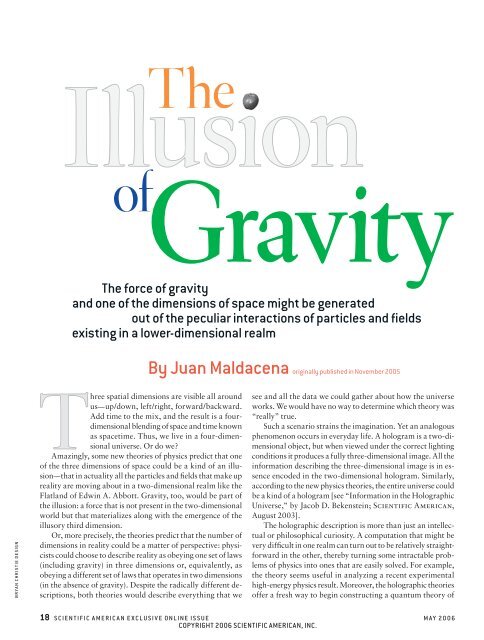Extreme Physics II - Physics and Astronomy
Extreme Physics II - Physics and Astronomy
Extreme Physics II - Physics and Astronomy
Create successful ePaper yourself
Turn your PDF publications into a flip-book with our unique Google optimized e-Paper software.
BRYAN CHRISTIE DESIGN<br />
The<br />
Illusion<br />
of<br />
Gravity Gravity<br />
The force of gravity<br />
<strong>and</strong> one of the dimensions of space might be generated<br />
out of the peculiar interactions of particles <strong>and</strong> fi elds<br />
existing in a lower-dimensional realm<br />
Three spatial dimensions are visible all around<br />
us—up/down, left/right, forward/backward.<br />
Add time to the mix, <strong>and</strong> the result is a fourdimensional<br />
blending of space <strong>and</strong> time known<br />
as spacetime. Thus, we live in a four-dimensional<br />
universe. Or do we?<br />
Amazingly, some new theories of physics predict that one<br />
of the three dimensions of space could be a kind of an illusion—that<br />
in actuality all the particles <strong>and</strong> fi elds that make up<br />
reality are moving about in a two-dimensional realm like the<br />
Flatl<strong>and</strong> of Edwin A. Abbott. Gravity, too, would be part of<br />
the illusion: a force that is not present in the two-dimensional<br />
world but that materializes along with the emergence of the<br />
illusory third dimension.<br />
Or, more precisely, the theories predict that the number of<br />
dimensions in reality could be a matter of perspective: physicists<br />
could choose to describe reality as obeying one set of laws<br />
(including gravity) in three dimensions or, equivalently, as<br />
obeying a different set of laws that operates in two dimensions<br />
(in the absence of gravity). Despite the radically different descriptions,<br />
both theories would describe everything that we<br />
By Juan Maldacena originally published in November 2005<br />
see <strong>and</strong> all the data we could gather about how the universe<br />
works. We would have no way to determine which theory was<br />
“really” true.<br />
Such a scenario strains the imagination. Yet an analogous<br />
phenomenon occurs in everyday life. A hologram is a two-dimensional<br />
object, but when viewed under the correct lighting<br />
conditions it produces a fully three-dimensional image. All the<br />
information describing the three-dimensional image is in essence<br />
encoded in the two-dimensional hologram. Similarly,<br />
according to the new physics theories, the entire universe could<br />
be a kind of a hologram [see “Information in the Holographic<br />
Universe,” by Jacob D. Bekenstein; Scientifi c American,<br />
August 2003].<br />
The holographic description is more than just an intellectual<br />
or philosophical curiosity. A computation that might be<br />
very diffi cult in one realm can turn out to be relatively straightforward<br />
in the other, thereby turning some intractable problems<br />
of physics into ones that are easily solved. For example,<br />
the theory seems useful in analyzing a recent experimental<br />
high-energy physics result. Moreover, the holographic theories<br />
offer a fresh way to begin constructing a quantum theory of<br />
18 SCIENTIFIC AMERICAN EXCLUSIVE ONLINE ISSUE MAY 2006<br />
COPYRIGHT 2006 SCIENTIFIC AMERICAN, INC.

















